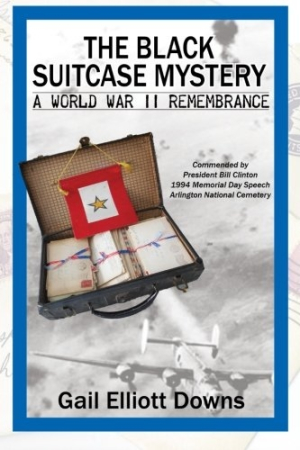The Black Suitcase Mystery
A World War II Remembrance
The Black Suitcase Mystery looks back on a loving project that put couples, children, and combat veterans into conversation with one another.
Gail Elliott Downs’s surprising education memoir The Black Suitcase Mystery recalls how she helped fifth graders become detectives.
Beginning in 1991 in a small town outside of St. Louis, Missouri, Downs, an elementary school librarian, introduced fifth graders to the basics of genealogical research, letting them pore through a black suitcase that once belonged to Hazel Elliott Rich, Downs’s great-aunt. This school project lasted until 1995 and found its way into a speech by then President Bill Clinton.
From this humble beginning, the story grows to involve a missing pilot, the famous Tuskegee Airmen, and two generations of US military veterans who are touched by the earnest appreciation of Downs’s Midwestern students. Down’s blow-by-blow rundown of the contents of the black suitcase shares how each letter and postcard came to matter to the Rich family and others.
Rather than telling a linear historical narrative, the book takes each letter from the black suitcase apart. These letters, which date to the 1920s, heap mysteries upon mysteries: why was George Elliott Rich, Hazel’s son, living in New Hampshire during his teen years while his mother lived in Detroit? And why did George stop sending letters during the height of the Second World War? The last mystery is solved by Downs’s intrepid students.
This is an enthralling story about remembrance, World War II, and the strong bonds of love between soldiers, airmen, and the women who waited for them. This love is shown in the letters, which are quoted at length. Though they are central to the story, in many instances entire pages are made up of passages from letters or of complete letters, hindering the pace. Subheadings and breaks in the story are a further impediment.
In this unadorned, modern tale, facts dominate; descriptions and adjectives are limited. Indeed, the entire story is written as one long love letter to the past. It experiments with form, as when it plays with an interview style. By its conclusion, the story comes full circle, and the class project is a national sensation.
Downs’s average, everyday students turned their class project into a World War II remembrance activity. Their project helped to solve a family mystery, but it also served as a blueprint for other schools interested in doing something similar to address the Greatest Generation. Comprehensive and beautiful, The Black Suitcase Mystery puts couples, children, and combat veterans into conversation with one another.
Reviewed by
Benjamin Welton
Disclosure: This article is not an endorsement, but a review. The publisher of this book provided free copies of the book and paid a small fee to have their book reviewed by a professional reviewer. Foreword Reviews and Clarion Reviews make no guarantee that the publisher will receive a positive review. Foreword Magazine, Inc. is disclosing this in accordance with the Federal Trade Commission’s 16 CFR, Part 255.

